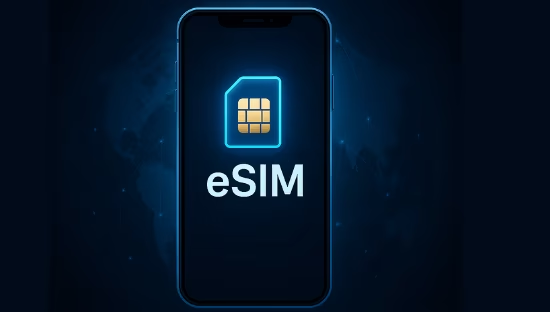
Everything You Need to Know About the EU eSIM
An eSIM (embedded SIM) is a digital SIM card that allows you to activate a cellular plan from your carrier without having to use a physical nano-SIM. Instead of inserting a card into your phone, an eSIM is embedded directly into the device. eu esim
With an eSIM, the SIM chip is soldered directly onto the motherboard instead of onto a removable module. This allows for remote provisioning of the SIM profile over-the-air without having to physically swap SIM cards. The onboard eSIM can contain multiple SIM profiles, allowing you to easily switch between carriers and plans if needed.
eSIMs work by storing data securely in a chipset that can be reprogrammed remotely. This allows the SIM profile to be downloaded and provisioned wirelessly. Once the cellular plan is activated on the eSIM, it works just like a regular nano-SIM card. eu esim
Some key benefits of eSIM technology include: eu esim
- Convenience There is no need to obtain, insert, or swap physical SIM cards to change carriers. Everything can be managed remotely over the air.
- Multi-SIM functionality – the ability to store multiple SIM profiles on a single eSIM and switch between them as needed. It is useful to have personal and business numbers on one device.
- Better security is more secure than physical SIM cards, which could potentially be stolen. Reduces SIM swapping fraud.
- Smaller hardware – With no need for a SIM slot, devices can be designed smaller and thinner without compromising cellular connectivity.
- Global roaming switching SIM profiles while traveling makes it easy to stay connected across borders.
So in summary, eSIM provides flexibility, convenience, and security compared to traditional physical SIM cards for cellular connectivity. The ability to remotely provision and manage plans over-the-air is the major benefit of this technology.
History of eSIM
eSIM was first introduced in 2016 by the GSM Association as part of their Remote SIM Provisioning initiative. The goal was to provide a standardized and interoperable solution to remotely manage cellular plans on devices. eu esim
Some key developments and milestones in the history of eSIM include the following:
- 2016 – The GSM Association publishes the first specification for eSIM, allowing remote provisioning of SIM profiles.
- 2016 – Apple introduces eSIM support with the iPhone 7, iPad Pro 9.7, and Apple Watch Series 2. This helps drive initial adoption of the technology.
- 2017 – Google launches the Pixel 2 and Pixel 2 XL, the first Android smartphones to support eSIM.
- 2018 – eSIM commercial rollouts begin, with carriers like AT&T, Verizon, and T-Mobile in the US launching support.
- 2018 – The GSMA publishes specifications for consumer eSIM for 4G/5G networks. This standardization helps increase adoption.
- 2019 – Foldable smartphones like the Samsung Galaxy Fold integrate eSIM for dual SIM capabilities.
- 2020 – iPhone 12 models launch with eSIM support as the sole embedded SIM, removing the physical SIM card slot.
- 2021 – Google announces eSIM support on the Pixel 6, and future devices will be eSIM-only. More carriers globally have launched eSIM support.
The evolution of eSIM has focused on making it easier for consumers to activate cellular plans from their device menu and switch between profiles. As adoption increases, eSIM promises more flexibility and improved connectivity.
eSIM in Europe eu esim
Europe has seen growing adoption of eSIM technology across the continent. According to a 2022 GSMA report, over 60% of European mobile network operators already support eSIM. Additionally, eSIM-capable device shipments in Europe reached 160 million units in 2021.
The major carriers that support eSIM in Europe include:
- Vodafone operates in multiple European countries, including Germany, Italy, Spain, and the UK. Vodafone launched eSIM support back in 2018.
- Deutsche Telekom – Germany’s largest telecom provider, enabled eSIM in 2019.
- Orange – available in France, Spain, Poland, and other European nations. Orange launched its eSIM service in 2018.
- Telefónica – Spanish telecom giant Telefónica brought eSIM to its O2 subsidiary in Germany and the UK in 2018.
- TIM – Italy’s leading carrier, has partnered with Samsung to launch eSIM services in 2019.
- Three operate eSIM services in Ireland, Sweden, Denmark, and the UK. Part of CK Hutchison Holdings, a multinational telecom company.
European consumers have quickly adopted eSIM-enabled smartphones like the iPhone 11, iPhone 12, and Google Pixel series. Analysts predict eSIM adoption will continue rising across Europe, reaching over 80% by 2025. The technology provides greater flexibility and convenience for frequent travelers. Businesses also benefit from multi-network eSIM for managing global fleets.
Benefits of eSIM
eSIMs offer several key benefits to consumers compared to traditional physical SIM cards:
Convenience
- eSIMs allow users to activate services and switch networks directly from their phone settings. No more having to obtain, insert, or swap out physical SIM cards.
- eSIMs enable seamless connectivity when traveling abroad. Users can access multiple carrier profiles and easily switch networks as needed.
- Over-the-air provisioning means eSIM activation can happen remotely. There is no need to visit a store to set up a service.
Flexibility to Switch Carriers
- With eSIMs, switching service providers is easier than ever. Users aren’t locked into a network and can change carriers on demand.
- Having multiple eSIM profiles empowers consumers to compare networks and select the best deal at any given time.
Dual SIM Functionality
- eSIMs enable having two or more active plans on the same device simultaneously.
- This allows using separate numbers for personal and business purposes on a single phone.
- Users can optimize costs by using the least expensive provider for different types of usage.
Challenges with eSIM
The adoption of eSIM faces some challenges that could slow its rollout.
Carrier Support Issues
Not all carriers currently support eSIM. Some carriers may be slow to add support or charge extra fees to use eSIM devices on their networks. This can limit consumer choice and create confusion.
There are also some technical challenges. For example, carriers must update their systems to support eSIM profiles and provisioning. As more devices adopt eSIM, it will require significant upgrades for carriers globally.
Limitations for Consumers
eSIM takes control of changing SIMs away from consumers. While beneficial in many ways, it does mean consumers can’t simply switch physical SIM cards to easily change carriers.
Most eSIM implementations don’t yet support having multiple active profiles. So consumers are limited to one active cellular plan at a time. Dual SIM functionality via eSIM is still in the early stages.
There are also questions about how eSIM will handle number portability and other logistics when consumers want to switch carrier plans. The processes are still being defined.
So while eSIM has many advantages, it will likely take some time to fully mature as carriers upgrade systems and smooth out the consumer experience. But the long-term benefits make it worth overcoming these initial limitations.
eSIM Security
eSIM technology offers increased security compared to traditional SIM cards in a few key ways.
- eSIM profiles are stored on the device rather than on a physical SIM card, making it more difficult for hackers to steal subscriber identity data. Since there is no physical SIM to remove, eSIM helps prevent SIM swap fraud.
- Remote SIM provisioning allows the subscription to be enabled, disabled, switched or updated over-the-air. This removes the need to physically access the device to manage the subscription.
- eSIM uses mutual authentication, meaning both the mobile network and device verify each other’s identity before enabling a connection. This prevents unauthorized access to the mobile network.
- End-to-end encryption protects eSIM communication between networks, platforms, and devices.
However, some potential security risks to consider with eSIM include:
- Malware or hackers exploit flaws in eSIM software to steal identities or enable fraudulent subscriptions. Keeping device software up-to-date is key.
- Possible vulnerabilities if eSIM standards are not properly implemented by device manufacturers. Rigorous security testing is important.
- Over-the-air provisioning is dependent on a stable internet connection. Losing connectivity could obstruct remote profile management.
- Backward compatibility with traditional SIM may lead to security gaps in supporting legacy technology.
Overall, eSIM technology raises the security bar compared to traditional SIM cards. However, continued vigilance around software vulnerabilities and network weaknesses is required to prevent eSIM profiles from being compromised.
eSIM for consumers
eSIM technology provides several benefits for average consumers. The main use cases are:
- Flexibility to switch between carriers easily – With an eSIM, you can remotely switch mobile carriers without having to physically change out a SIM card. This makes it easy to take advantage of promotions from new carriers or switch if you’re unsatisfied with your current service.
- Ability to have multiple plans on one device – eSIM-enabled devices allow you to download multiple profiles, so you can have both a personal and business line on your smartphone, for example. This removes the need to carry multiple devices.
- Improved user experience – Having an integrated eSIM chip leads to a streamlined user experience without the need to fumble with physical SIM cards.
Some of the most popular consumer devices that currently support eSIM include:
- iPhone: The iPhone 13 and later models all support eSIM.
- iPad: The iPad Pro 11-inch (2018) and later models, and the iPad Air (2022) and later models all support eSIM.
- Samsung Galaxy S22 and later models: These phones all support eSIM.
- Samsung Galaxy Tab S8 and later models: These tablets all support eSIM.
- Google Pixel 6 and later models: These phones all support eSIM.
- Google Pixel Fold: This phone is expected to support eSIM.
- Apple Watch Series 4 and later models: These watches all support eSIM.
- Samsung Galaxy Watch4 and later models: These watches all support eSIM.
- Fitbit Versa 3 and later models: These watches all support eSIM.
- Amazfit Bip U Pro: This watch supports eSIM.
So in summary, eSIM delivers advantages like flexibility, multi-line capability, and an improved user experience for today’s consumers. And support for it is growing across flagship consumer smartphones and tablets.
eSIM for Businesses
eSIM technology provides several key benefits for enterprises and businesses:
Cost Savings
With eSIM, businesses no longer need to manage physical SIM cards for all of their devices and employees. This reduces logistical costs as well as expenses related to SIM card replacement, damage, or loss. eSIM allows over-the-air provisioning of connectivity, eliminating these costs.
Flexibility
eSIM makes it easy to change mobile network operators and data plans remotely. This allows businesses to optimize connectivity and costs as needs change without physically swapping SIM cards. Employees can be instantly set up with mobile plans optimized for different locations or use cases.
Security
eSIM offers enhanced security compared to physical SIM cards. Because there is no removable card, the risk of SIM swapping or SIM theft is eliminated. eSIM profiles are securely stored on the device. This prevents unauthorized access to the mobile subscription.
Device Management
With eSIM, enterprises can provision and manage mobile network connectivity across all devices centrally through a unified interface. This streamlines device deployment, configuration, and management.
Use Cases
Some examples of eSIM benefits for businesses:
-
Retailers can instantly activate connectivity for point-of-sale devices shipped to different stores.
-
Field service businesses can deploy workers with location-specific data plans optimized for their region.
-
Rental car companies can onboard customers without needing physical SIM card stocking and management.
-
IoT networks can connect sensors and devices across different locations flexibly.
As more carriers support eSIM globally, it will become an invaluable connectivity management tool for enterprises.
The future of eSIM eu esim
The eSIM market is expected to grow rapidly in the coming years as more devices adopt the technology. According to , the global eSIM market size is projected to grow from 4.6 billion EUR in 2022 to over 10 billion EUR by 2027, at a CAGR of 17%.
Some key trends that will drive eSIM adoption include:
-
Increased usage in smartphones – More smartphone makers like Apple, Samsung and Google are incorporating eSIMs into their devices. This allows consumers to easily switch carriers or have multiple plans.
-
Growth in IoT and wearables – eSIMs are ideal for connected devices due to their small size. The technology will see increased usage in smartwatches, fitness trackers, smart home devices, industrial IoT, and more.
-
Adoption in the automotive sector – Connected vehicles are integrating eSIMs for LTE connectivity. This enables features like real-time navigation, roadside assistance, and entertainment.
-
Deployment in laptops and tablets – Laptops and tablets with cellular connectivity are also switching to eSIM for simplicity and convenience.
Exciting new applications of eSIMs include:
- 5G connectivity – eSIMs will be critical for easy activation of 5G across different carriers. This can enable faster speeds and lower latency.
- Dual SIM devices – Phones with dual eSIM slots allow two active connections, personal and business lines, for example.
- Global roaming – eSIM profiles can make international roaming easy without physical SIM swaps.
- Embedded payments – eSIM-based devices could enable contactless payments, with eSIMs storing payment credentials securely.
Overall, the eSIM market outlook is very promising. As more companies recognize the benefits of eSIMs, they will continue driving innovation and new implementations across consumer and enterprise domains.
Conclusion eu esim
eSIM (embedded SIM) represents an exciting evolution in SIM card technology. By integrating the SIM chip directly into a device, eSIM enables more seamless connectivity, easier switching between carriers, and potential new applications.
Key takeaways around eSIM in Europe include: eu esim
- eSIM makes the process of activating and switching between carriers entirely digital. This eliminates the need for physical SIM cards.
- It provides more flexibility and convenience for consumers to change carriers or have multiple plans across devices.
- eSIM enables new applications like dual SIM functionality on a single device.
- For businesses, eSIM can streamline IoT connectivity across fleets of devices.
However, some challenges remain around standardization, implementation costs, and carrier support. As the technology matures, we may see eSIM become the default globally. But in the interim, the physical SIM still retains advantages.
Overall, eSIM presents an exciting vision of the future. As it evolves, it promises more seamless connectivity, greater consumer freedom, and innovations we can scarcely imagine today. The full promise of eSIM remains on the horizon. But with continued development, it could become a transformative technology across Europe and the world. eu esim



















